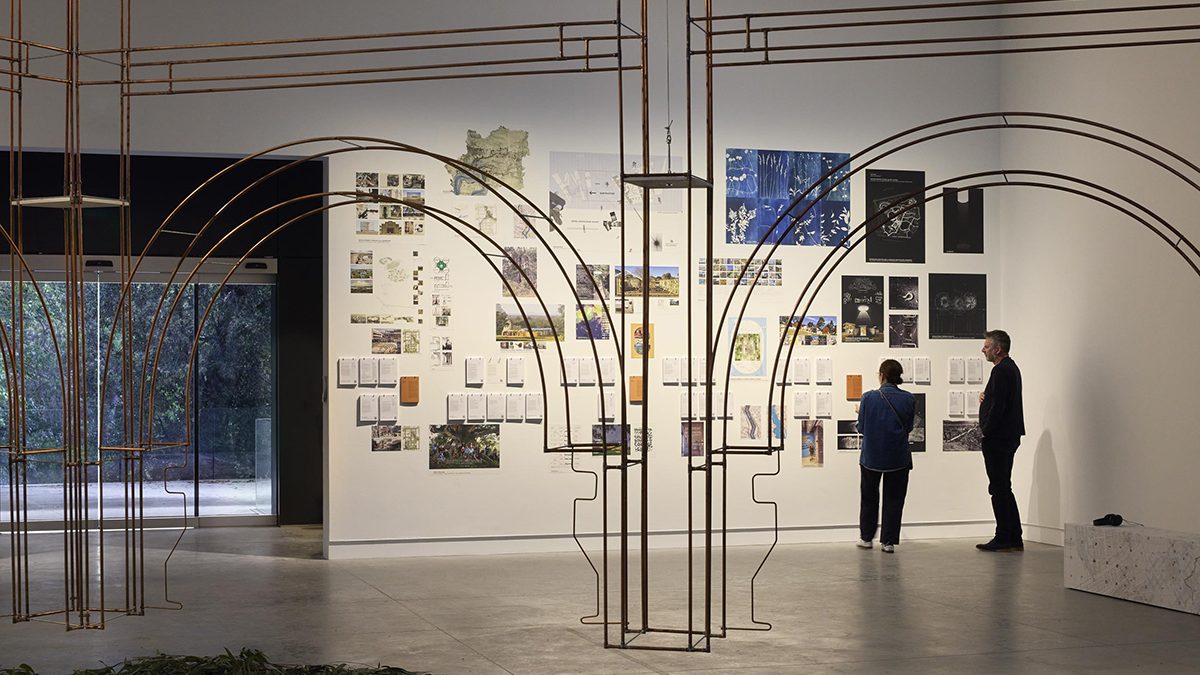By Anna Snoekstra
In its ninth exhibition at the Venice Biennale, the Australian Institute of Architects subtly unpicks the fabric of colonial identity.
The theme for this year’s La Biennale di Venezia is ‘The Laboratory of the Future’. For Lesley Lokko, curator of the 18th International Architecture Exhibition, it is more than just a theme; she sees the exhibition itself as a futuristic laboratory, a unique environment where discussions and imaginings about the importance of the architecture field can unfold.

From the creative directors appointed to lead Australia’s exhibition—Julian Worrall, Emily Paech, Anthony Coupe, Ali Gumilya Baker and Sarah Rhodes—the response is Unsettling Queenstown, a multisensory exhibition that seeks to ‘de-map’ Australia’s colonial past and reimagine its future. At its centre is a huge, haunting, suspended wire model of a belvedere tower constructed of copper tubing—a 70 per cent-scale replica of the Empire Hotel in Queenstown on the west coast of lutruwita (Tasmania). It serves as a symbol of colonialism and is accompanied by a series of immersive sounds, voices and images that reveal concealed stories. Worrall, a professor of architecture at the University of Tasmania, has long pursued a multifaceted inquiry into ‘alternative modernities’ in architecture and urbanism. His work has been mostly focused outside of Australia, specifically Japan, so this project allowed him to recentre locally. He teamed up with Paech, senior designer at Adelaide architecture firm Mulloway Studio, who took on design, fabrication and coordination. From there, Paech formed a dream team with Coup, Baker and Rhodes. Coup is a former president of the South Australian chapter of the Australian Institute of Architects currently undertaking a PhD in spatial storytelling. Baker is a multidisciplinary artist guided by Mirning heritage, a lecturer, and member of First Nations academic-artist group Unbound Collective. Rhodes, meanwhile, is a photographic artist who explores the relationship between the natural environment and an individual’s inner world. Paech says:
“The exhibition is inspirational, evocative and a representation of the diversity of contemporary architectural thinking.”
She adds that the act of imagining the future could not come without first acknowledging the traumas of the past. The team saw the 2023 Venice Biennale as an opportunity to open a conversation about Australia’s built and natural histories, leveraging the latest architectural intelligence around decolonisation and designing with Country. The installation explores these themes of decolonisation and decarbonisation through the construct of Queenstown, a place name used in various former British Empire territories including Australia, New Zealand, Asia, Africa and the Americas. In fact, there is a Queenstown on every continent bar Antarctica. Although the focus is on lutruwita’s Queenstown, a copper-mining town on the island’s west coast, Queenstown is also treated conceptually—at once highlighting how the imperial hangover is pervasive in every corner of the globe, and inviting decolonial thinking. It serves as a symbolic intersection where the traumas of the past are transformed into the driving forces of the future. A series of Rhodes’ photographs are also displayed, depicting barren mountains, a polluted river, and abandoned structures in the lutruwita town; reflections of the environmental and social toll of an extractive relationship with nature. These photographs, along with the representations of de-mapped Country are part of a broader archive also containing soundscapes, videoscapes and other ephemera exploring themes of temporality and narrative, offering possibilities to reimagine the future and transcend the confines of our inherited Queenstowns.
Unsettling Queenstown is displayed in the Denton Corker Marshall-designed Pavilion of Australia within the Giardini della Biennale until 26 November.
